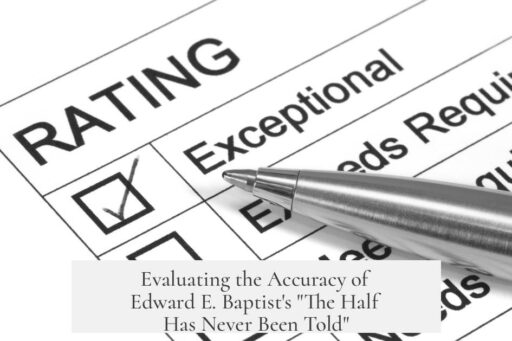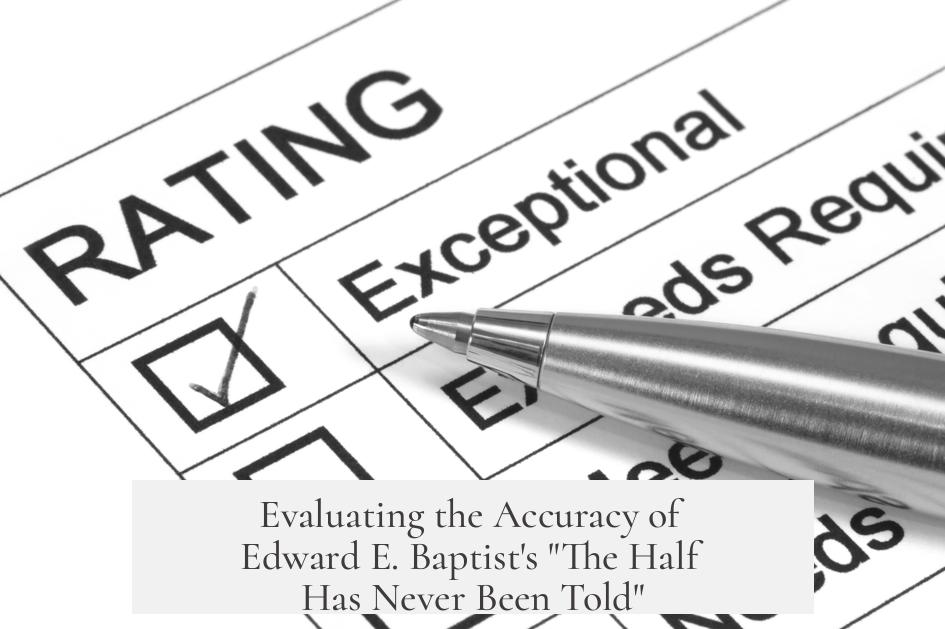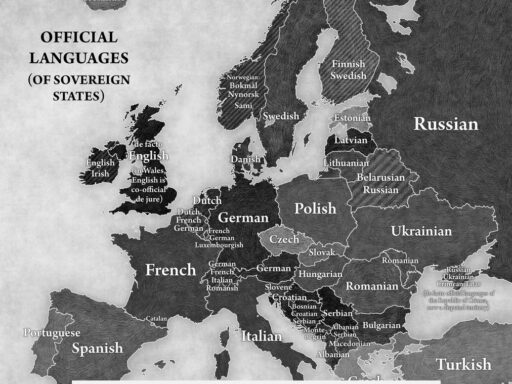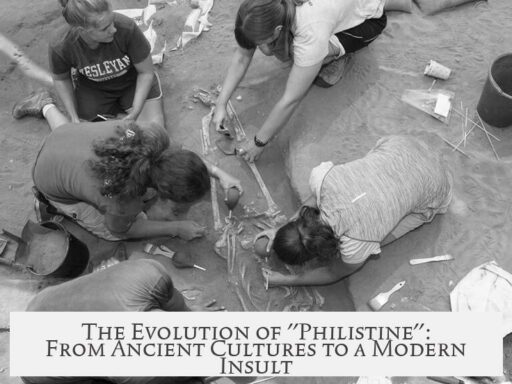Edward E. Baptist’s The Half Has Never Been Told faces significant criticism over its accuracy, particularly concerning economic calculations, historical methods, and use of existing research, calling into question its central thesis about slavery’s role in the U.S. economy and the ‘pushing system.’

The foremost critique centers on Baptist’s economic calculations. He claims slavery and related industries accounted for nearly half of the U.S. economy before the Civil War. This figure stems from aggregating gross values across various sectors linked to slave-grown cotton—inputs, outputs, transport, and services—and comparing that sum directly to GDP. However, this approach violates basic macroeconomic accounting rules. GDP is a net figure representing value added, not sums of gross outputs, so combining gross figures across sectors results in double-counting. Consequently, Baptist’s 50% estimate significantly overstates slavery’s economic share. This error undermines the quantitative backbone of his argument about slavery’s economic dominance.
Methodologically, Baptist’s portrayal of the cotton plantation labor system—specifically the ‘pushing system’—faces serious challenges. The ‘pushing system’ suggests that planters continually ratcheted up quotas for enslaved workers, calibrating violent punishments to maximize cotton picking productivity. Baptist advances this idea as central to his narrative of escalating brutality. Yet, historical evidence contradicts this claim. Cotton yields varied due to uncontrollable factors such as soil, weather, and plant variety, making fixed, ever-increasing quotas impractical. Detailed empirical research by economists Alan Olmstead and Paul Rhode, analyzing extensive cotton-picking records, finds little evidence of systematic quota increases tied to violence. Although enslaved workers endured harsh treatment, rigid quotas and progressive quota increases—key features of the ‘pushing system’—do not appear in plantation records. This challenges both the existence and central importance of the ‘pushing system’ as Baptist frames it.

Baptist’s use of Olmstead and Rhode’s research on productivity in the antebellum cotton economy further complicates his thesis. Olmstead and Rhode document a near quadrupling of productivity per worker in upland cotton due to biological innovations—mainly the introduction of Mexican cotton varieties—with no comparable growth in sea island cotton productivity. Their central argument attributes rising productivity to this innovation rather than labor intensification or violence. Baptist uses their graph depicting this productivity increase but omits referencing their conclusion. Instead, he attributes the increase to escalating brutality under the ‘pushing system.’ This selective interpretation involves a serious scholarly oversight by ignoring the original authors’ reasoning and not addressing their contrasting explanation. It weakens Baptist’s argument by disconnecting data from the interpretation supported by the primary researchers.
The sum of these issues points to broader concerns about scholarly rigor in Baptist’s work. It is legitimate to explore themes of violence and coercion in the economics of slavery, but misapplying macroeconomic data, misrepresenting historiographical debate, and repurposing evidence without engaging opposing views breach academic standards. Such flaws are not merely technical errors or disciplinary disagreements. They constitute fundamental problems that compromise the credibility of Baptist’s main claims. The critiques thus highlight the need for a nuanced, accurate treatment of slavery’s economic role and labor dynamics rooted in sound methodologies and honest engagement with existing scholarship.

- Baptist’s estimate that slavery accounted for half the U.S. economy involves a double-counting error in macroeconomic accounting.
- The ‘pushing system’ model of quotas and calibrated violence lacks historical evidence in cotton-picking records.
- Baptist selectively uses Olmstead and Rhode’s research, ignoring their biological innovation explanation for productivity gains.
- These methodological and interpretive flaws undermine the central thesis of The Half Has Never Been Told.
Unpacking the Accuracy of Edward E. Baptist’s The Half Has Never Been Told
Is Edward E. Baptist’s The Half Has Never Been Told historically accurate? The answer involves a layered critique of his economic calculations, historical methodology, and use of existing scholarly research. While the book delivers an emotionally gripping narrative on American slavery, its factual foundation, especially economic aspects and some interpretations, faces serious challenges.

Let’s dig into the controversy with clarity and even a touch of dry wit — because history deserves precision, not fluff.
Economic Miscalculation: When Math Goes Awry

The largest red flag lies in Baptist’s calculation of slavery’s economic share. He asserts that slavery and related activities represented nearly half of the US economy in the Antebellum period. Sounds impressive, right?
Here’s the problem: Baptist commits a classic accounting blunder — he double-counts economic activity. By summing all gross values linked to slave-grown cotton—inputs, outputs, transportation, downstream services—and then comparing this massive total to the net GDP, he inflates slavery’s share drastically.
Think of it this way: It’s like adding up the price of every ingredient, every chef’s salary, and every delivery fee for a pizza, and then comparing that to the final cost of that pizza sold. You’d obviously overshoot the real value.
This misuse of macroeconomic accounting principles is not a small slip. It skews how central slavery was economically, which forms a pillar of Baptist’s argument. It’s not just a math error, but a foundational flaw in the economic claims.
Methodological Misrepresentation: The Myth of the ‘Pushing System’
Another core piece of Baptist’s narrative is the “pushing system”: a supposed method where slavery managers continuously ratchet up cotton-picking quotas, punishing slaves if they failed to hit them, then increasing quotas in a spiral of calibrated violence.
Sounds brutal, and Baptist’s book paints this as a central, historically accurate mechanism driving cotton production. But hold on. This idea faces deep scrutiny and largely fails to survive a close look at the evidence.
Leading historians and economists Olmstead and Rhode have painstakingly examined picking records. They find quotas were rarely, if ever, systematically increased. Cotton yields fluctuate heavily due to weather, soil quality, and countless other factors outside workers’ control. A rigid quota system would’ve been counterproductive and unrealistic.
Slaves suffered brutal treatment, undeniably. But that brutality wasn’t precisely tied to a relentlessly increasing quota regime. The “pushing system” as a mechanical tool for productivity gains? There’s little historical support for this.
Misusing Olmstead and Rhode’s Research: A Graph and Its Confusing Tale
A crucial graph in Baptist’s book comes from well-known research by Alan Olmstead and Paul Rhode. Their article, “Biological Innovation and Productivity Growth in the Antebellum Cotton Economy,” shows near quadrupling of worker productivity on plantations growing upland Mexican cotton. The authors argue that this was due to biological innovations—new cotton varieties—not increased coercion.
Baptist, however, sidesteps their core claim. Instead, he uses their graph to support his “pushing system” idea, without acknowledging their explicit point: productivity gains came from biological factors, not escalating brutality.
In fact, Baptist never formally engages with or cites their argument. This is shocking because he requested permission to use the graph from the authors themselves.
This maneuver resembles borrowing a map from a friend only to claim you discovered the city layout yourself — but in reverse. It’s a textbook misappropriation that undercuts the book’s credibility.
Scholarly Standards and What This Means for Baptiste’s Thesis
Suggesting that escalating violence might have played some role in cotton productivity is fair game. Historians debate all sorts of possibilities. But scholarship demands rigor. You need to make your argument clearly, engage honestly with existing research, and avoid misrepresenting sources.
Unfortunately, Baptist misses this mark. He repurposes and distorts data without proper engagement or justification. The consequences are serious: the book’s central thesis about the economic might of slavery and the mechanics of cotton picking suffers a major blow.
This issue isn’t just some picky academic quarrel. It undermines a foundational interpretation that shaped how many see slavery’s role in American economic history.
So What Does This Mean for Readers?
Should you disregard The Half Has Never Been Told? Not necessarily.
Baptist’s storytelling shines a harsh light on the brutal realities of slavery. His vivid accounts of suffering and violence bring critical human perspectives to history that traditional economics often miss. The emotional resonance is powerful and necessary.
Yet, when using this book as a historical source, treat economic claims and some methodological points with skepticism. Cross-check with other scholarly works, especially research by Olmstead, Rhode, and economic historians, to get a fuller, more accurate picture.
In other words: enjoy the story but keep your critical thinking cap firmly on.
Final Thoughts: The Importance of Balanced History
Historical understanding requires weighing narratives against evidence. Baptist’s work reminds us that slavery was horrific and economically important. But overstating facts or misusing data weakens the cause of truth.
Could increased brutality have contributed to productivity gains? Possibly. But any claim merits strong evidence, clear argument, and proper scholarly conduct.
The debate sparked by The Half Has Never Been Told ultimately pushes historians and economists to refine their methods and narratives. If anything, this controversy encourages more rigorous and honest scholarship on a painful yet crucial chapter of American history.
What do you think? Does separating the narrative impact from the economic facts change how you view the institution of slavery’s economic role?




